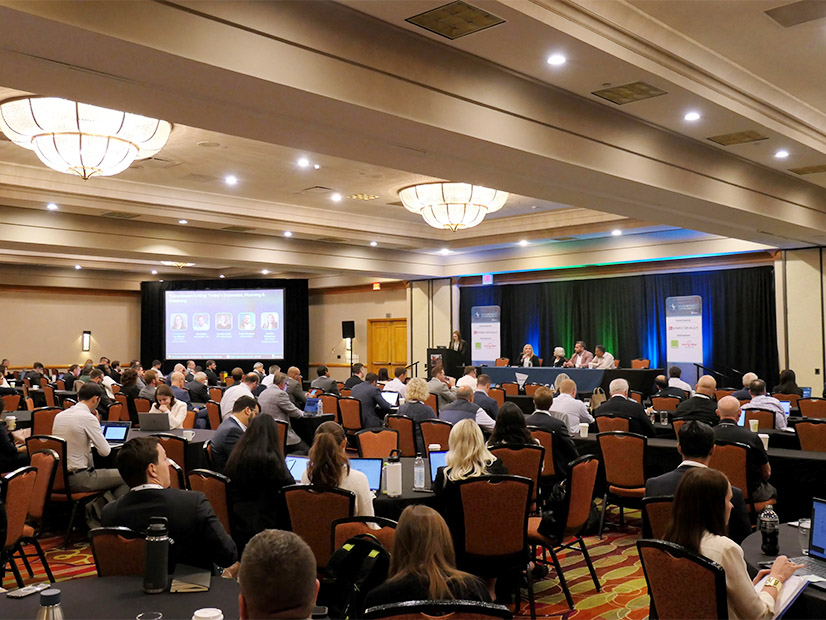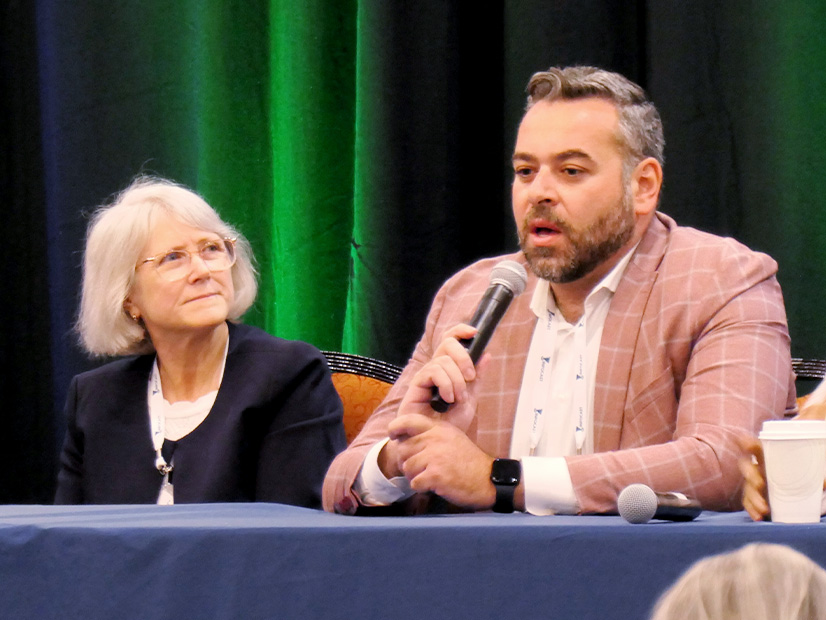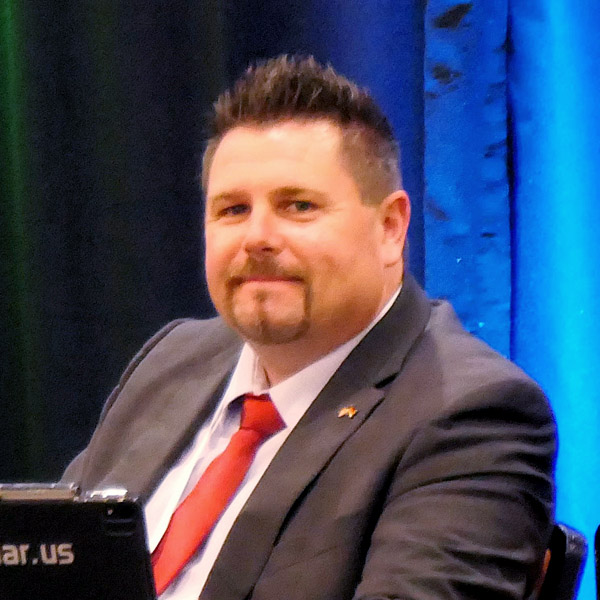
INDIANAPOLIS — Infocast’s inaugural Midcontinent Clean Energy summit last week provided panelists a pulpit for critiquing MISO’s interconnection queue setup as it strains under the weight of hundreds of gigawatts intended to further the clean energy transition and match load growth.
Engie Director of Engineering Ruchi Singh said “there needs to be a more holistic view” at MISO on how to streamline its interconnection queue, rather than proposing ideas that only serve to discourage developers from submitting queue projects.
She was referring to MISO’s stepped-up queue requirements that involve higher study fees, more definitive proof of site control and automatic penalties that grow more expensive the longer projects have stayed in the queue before withdrawing. Beyond those, MISO still hopes to cap the projects that may enter the queue each year at 50% of the footprint’s annual peak load. (See MISO Sets Sights on 50% Peak MW Cap in Annual Interconnection Queue Cycles.)
Singh questioned whether that last rule would be the best method for getting the queue under control. She said the footprint might be better served by volumetric price escalation rules, in which MISO raises interconnection customers’ fees and penalties as individual developers submit more projects to the queue for study. She said MISO should explore that more equitable method rather than “chasing a number.”
If MISO ultimately finds that it needs a megawatt cap, Singh said it should establish a “transparent and fair” process for calculating the megawatt threshold beyond throwing out a percentage.
Strata Clean Energy’s Michael Russ said MISO should be careful formulating annual queue caps because the nameplate capacity of projects are not their eventual accredited capacity values. He implied MISO could inadvertently risk its resource adequacy.
Russ also said developers tend to flood the queue with projects “because there’s so low certainty because of the four to five queue cycles in front.” They attempt to anticipate an “almost infinite” number of interconnection scenarios for their projects as higher-queued projects drop out and affect subsequent submittals in the queue.
“It’s nearly impossible. It’s probably why I’ve lost most of my hair,” he said. He recommended MISO devote itself to confirming study results sooner and more definitively.
Chris Lazinski, head of strategy and origination at BayWa r.e. Americas, said MISO’s interconnection process has become the “long tent pole” in getting projects to commercial operation, replacing permitting as the biggest hurdle. He said MISO may want to introduce new “gradations” of interconnection service for generators that cannot meet the full requirements for participation as capacity resources. He suggested more levels of interconnection service to match generators’ service level with their output abilities.
Sergio Garcia, executive director of project finance at Rabobank, which invests in projects in the MISO queue, said it would be nice to close a deal with guaranteed network upgrade costs. He said currently, network upgrade costs in MISO are not finalized until much later in the process than in other RTOs because the costs remain contingent on other queued projects, with upgrade costs spread on a pro rata basis.
“Most projects die on interconnection costs,” Garcia said.
“The numbers fluctuate so wildly based on who drops out of the queue,” said Kristina Shih, a partner at private equity fund Segue Sustainable Infrastructure. Shih said investment firms will lean on supplemental studies outside of MISO or consultants to figure out if it makes financial sense to keep paying the RTO’s milestone fees to remain in the queue.
Prudential Private Capital Senior Vice President Ty Bowman said it is understandable under the current queue atmosphere that developers with more means would add queue positions to mitigate attrition rates of other projects.
Heath Norrick, director of Deriva Energy’s renewable business development (formerly Duke Energy Renewables), said MISO’s higher queue fees and withdraw penalties will “unquestionably” tamp down competition over time, driving out smaller generation developers and leaving larger developers with most queue slots.
Queue Cap a Sound Idea?
Brad Pope, the Organization of MISO States’ head of regulatory and legal affairs, said that though an annual megawatt cap on the queue might be a “crude instrument,” it appears necessary for MISO’s planning engineers to be able to overcome the study complexities of too many projects.
“We are getting to a point that’s second only to the Industrial Revolution,” Pope said of the explosion in data center development and the new electricity needed to serve them.
SB Energy’s Karl Brutsaert said that even quality clean energy projects today are threatened by MISO’s massive annual queue cycles, in which the collective nameplate capacity rivals the RTO’s annual peak load. He said MISO seems to be struggling to separate the “wheat from the chaff.” He said that while there is “tons of demand,” it remains “very difficult to meet that demand.”
EDF Renewables’ Erik Ejups said that even with MISO planners doing what they can to propose long-range transmission portfolios to accommodate future generation, it appears developers are poised to “blow their faces off again” with a flood of queue submittals year after year. “It’s kind of a loop.”
Triple Oak Power COO Ryan Leonard said it would likely be valuable for MISO to simultaneously analyze new load and any companion generation proposed to exclusively serve it.
Jonathan Pike, vice president of corporate development at Earthrise Energy, said developers are not expecting MISO to be able to complete studies and move to interconnection agreements in a matter of a few months. He said developers know that some amount of uncertainty and wait times will always be a feature of interconnection queues. But he said the current level of unknowns in the MISO queue are untenable.
“What we need is a manageable amount of risk and uncertainty,” he said.
Time-limited Leases
Wells McGiffert, vice president of business development at PRC Wind, which has been developing projects in MISO for about 30 years, said site control requirements can become tricky when some jurisdictions limit the span of land lease agreements.
“We have to be very genuine to our landowners and say, ‘We can only sign this lease for five years, but this project is going to take eight years to develop.’ … When it can take eight to 10 years, they can be along for a ride,” he said.
Gordon Baier, CEO and co-founder of GoSolar Energy, recommended developers be upfront about timelines and warn landowners who agree to host projects that renewable energy development is a yearslong process. He said landowners can become frustrated with delays and want to break leases and sell land.
Baier advised developers to secure long-term leases when they can to account for queue study delays.
“That is a risk for us because we have all the ingredients on the table, but we’re in two to three years of backlog. … This is a massive risk,” he said.
Baier recommended developers first hold “one-to-one discussions with key landowners” to get them comfortable with projects before holding community sessions on utility-scale renewable projects. He said that when developers approach landowners individually, they should ask landowners about their inheritance plans for their land and try to convince them to replace “conventional farming with sun farming.”
“They think they’ll agree to a project, and it will be built the next year,” agreed McGiffert. He advised managing expectations and taking a gentle approach where developers don’t come in assuming a project is a foregone conclusion.
“It’s not our land. We try to ask permission to come to the community. … We don’t want to force and pit neighbors against each other,” McGiffert said.
Transmission Planning and Remaking the Grid
More than $35 billion across two major transmission portfolios is being readied for MISO’s Midwest region, which stands to ease interconnection backlogs. However, that help is still years away.
ITC Holdings’ Cynthia Crane asked the audience to remember that MISO’s first, $10 billion Long Range Transmission Planning (LRTP) portfolio, and the second, potentially $25 billion LRTP portfolio face a multiyear process studded with permitting and siting challenges, supply chain issues and labor shortages.
“It’s fabulous that we’ve gone through this planning cycle and got the projects approved, but now we have to get to work,” Crane said.
“We’re behind on transmission — almost a decade — if you think about how long it’s going to take to build [LRTP] Tranche 1, by 2030, and Tranche 2 sometime around 2040,” said Arash Ghodsian, Invenergy vice president of transmission and policy.
Ghodsian said given that development has lagged, MISO should seriously consider proposing HVDC lines in upcoming LRTP portfolios or its regularly scheduled annual planning.
“If you wait for cost allocation, you’re never going to build anything,” Ghodsian said. However, he said he thought MISO South, long allergic to major, regional projects, is beginning to warm to the idea of intensive planning, with some southern members asking for planning.
Ghodsian said he’s optimistic that FERC’s recent Order 1920, which seeks to make long-term planning more standard and commonplace, will spur a boom in interregional planning.
“The hope is that 1920 can set the groundwork for these kinds of coordination,” Ghodsian said.
David Mindham, EDP Renewables’ director of regulatory and market affairs, said nationally the zeitgeist of load growth and fleet transformation means that there has never been a better time to remake the grid. He said for maybe the first time, there are “coherent national strategies” to guide buildout.
Mindham said MISO should shift some focus from making it more challenging for generation developers to enter the interconnection queue to making sure its transmission owners complete timely network upgrades for projects.
While it’s “impressive” that MISO’s long-range transmission planning is set to total more than $30 billion soon, he continued, in-service dates are still years away. In the meantime, MISO and its TOs could become better at implementing near-term solutions to open up capacity on the transmission system, like reconfiguration plans and grid-enhancing technologies. He said developers are willing to pay for the costs of reconfiguring flows if it means their projects don’t have to wait additional years for commercial operation.
“We need to be better at getting projects online and reducing curtailment,” Mindham said.





